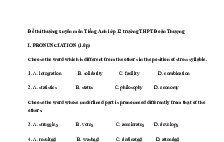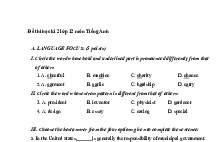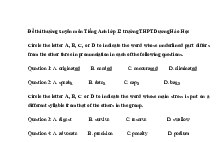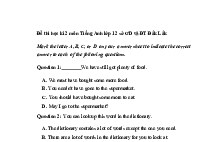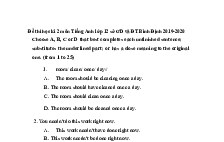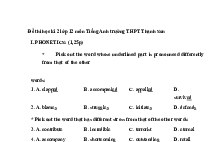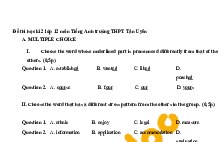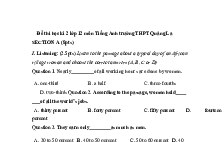Bộ đề thi thử THPT Quốc gia năm 2016 môn Tiếng Anh - Số 1
Nội dung tài liệu
Tải xuốngCác tài liệu liên quan
-
![Đề thi thường xuyên môn Tiếng Anh lớp 12 trường THPT Đoàn Thượng]()
-
![Đề thi học kì 2 lớp 12 môn Tiếng Anh]()
-
![Đề thi thường xuyên môn Tiếng Anh lớp 12 trường THPT Dương Háo Học]()
-
![Đề thi học kì 2 môn Tiếng Anh lớp 12 sở GD và ĐT Đắk Lắk]()
-
![Đề thi học kì 2 môn Tiếng Anh lớp 12 sở GD và ĐT Bình Định 2019-2020]()
-
![Đề thi học kì 2 lớp 12 sở GD và ĐT Đồng Tháp]()
-
![Đề thi học kì 2 lớp 12 môn Tiếng Anh trường THPT Thanh Sơn]()
-
![Đề thi học kì 2 lớp 12 môn Tiếng Anh trường THPT Tân Uyên]()
-
![Đề thi học kì 2 lớp 12 môn Tiếng Anh trường THPT Quảng La]()
-
![Đề thi học kì 2 lớp 12 môn Tiếng Anh trường THPT Phú Mỹ]()
Có thể bạn quan tâm
Thông tin tài liệu
QUANG TRI DEPARTMENT OF EDUCATION & TRAINING THE STATE’S HIGH SCHOOL GRADUATION EXAMINATION MOCK TEST No.1 DONG HA HIGH SCHOOL Allotted time: 90 minutes Academic Year: 2014-2015 Candidate Full Name: ………………………………………………………… - Candidate No.
……… PART 1: MULTIPLE CHOICE (0.125 x 64 = 8.0p) Read the following passage and mark the letter A, B, C, or D on your answer sheet to indicate the word or phrase that best fits each of the numbered blanks.
The Planets of Jupiter The largest of the giant gas planets, Jupiter, with a volume 1,300 times greater than Earth’s, contains more than twice the mass of all the other planets combined.
It is thought to be a gaseous and fluid planet without solid surfaces, Had it been somewhat more massive, Jupiter might have attained internal temperatures as high as the ignition point for nuclear reactions, and it would have flamed as a star in its own right.
Jupiter and the other giant planets are of a low-density type quite distinct from the terrestrial planets: they are composed predominantly of such substances as hydrogen, helium, ammonia, and methane, unlike terrestrial planets.
Much of Jupiter’s interior might be in the form of liquid, metallic hydrogen, Normally, hydrogen is a gas, but under pressures of millions of kilograms per square centimeter, which exist in the deep interior of Jupiter, the hydrogen atoms might lock together to form a liquid with the properties of a metal.
Some scientists believe that the innermost core of Jupiter might be rocky, or metallic like the core of Earth.
Jupiter rotates very fast, once every 9.8 hours.
As a result, its clouds, which are composed largely of frozen and liquid ammonia, have been whipped into alternating dark and bright bands that circle the planet at different speeds in different latitudes.
Jupiter’s puzzling Great Red Spot changes size as it hovers in the Southern Hemisphere.
Scientists speculate it might be a gigantic hurricane, which because of its large size (the Earth could easily fit inside it), lasts for hundreds of years.
Jupiter gives off twice as much heat as it receives from the Sun.
Perhaps this is primeval heat or beat generated by the continued gravitational contraction of the planet.
Another star like characteristic of Jupiter is its sixteen natural satellites, which, like a miniature model of the Solar System, decrease in density with distance from rocky moons close to Jupiter to icy moons farther away.
If Jupiter were about 70 times more massive, it would have become a star, Jupiter is the best-preserved sample of the early solar nebula, and with its satellites, might contain the most important clues about the origin of the Solar System.
1.
The word attained in paragraph 1 is closest in meaning to _____.
A.
attempted B.
changed C.
lost D.
reached C.
terrestrial D.
substances 2.
The word they in paragraph 1 refers to _____.
A.
nuclear reactions B.
giant planets 3.
According to the passage, hydrogen can become a metallic-like liquid when it is _____.
A.
extremely hot B.
combined with helium C.
similar atmospheres D.
metallic cores 4.
According to the passage, some scientists believe Jupiter and Earth are similar in that they both have _____.
A.
solid surfaces B.
similar masses C.
similar atmospheres D.
metallic cores 5.
The clouds surrounding Jupiter are mostly composed of _____.
A.
ammonia B.
helium C.
hydrogen D.
methane 6.
It can be inferred from the passage that the appearance of alternating bands circling Jupiter is caused by _____.
A.
the Great Red Spot B.
heat from the Sun C.
the planet’s fast rotation D.
Storms from the planet’s Southern Hemisphere 7.
The author uses the word puzzling in paragraph 2 to suggest that the Great Red Spot is _____.
A.
the only spot of its kind B.
not well understood C.
among the largest of such spots D.


